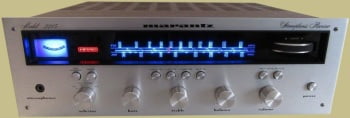
Introduced in 1978, the Marantz 1550 receiver was part of the 15xx series that included the 1515, 1530, and 4025. Superscope owned the Marantz brand at the time and Philips would buy them from Superscope a couple years later in 1980. The 1550 produced 50 watts per channel into 8 ohms and was the top of the line in the 15xx series.
The 1550 design did away with the iconic gyro tuning wheel that most associate with Marantz stereos. Still, the design is sleek and well balanced.

Front Panel
The Marantz 1550 receiver’s front panel offers a range of controls for customizing audio output and managing various input sources. The Speaker System switches allow you to select between two sets of speakers or operate both simultaneously. These switches can be disengaged to use headphones exclusively.
You can tailor the sound of the 1550 through several specialized switches and controls. The Mode switch can convert stereo signals to mono for improved reception of weak signals or to reduce noise when playing mono sources. The Loudness switch enhances bass and treble at low volumes, while Hi and Low Filter switches help reduce unwanted high and low-frequency noise, respectively. Fine-tuning of audio is further possible with the Bass, Mid, and Treble controls.
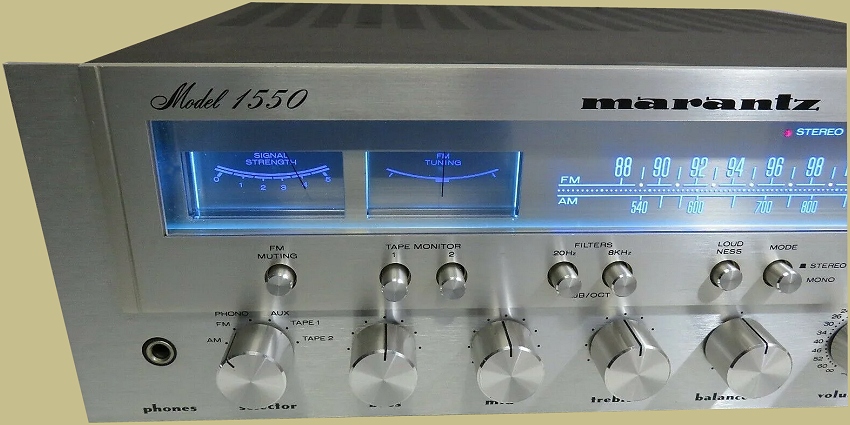
The Tape Monitor switches allow monitoring and dubbing between two tape decks. The Selector switch allows you to choose between various input sources, routing the selected signal to all front panel controls and the Tape Monitor Out jacks.
The Marantz 1550 receiver has two tuning meters: a Signal Strength meter for both AM and FM broadcasts, and an FM Tuning meter for precise station tuning. The FM Muting switch helps eliminate inter-station noise when scanning FM frequencies. The Balance control allows for adjustment between left and right speakers, with a center detent for optimal stereo imaging.
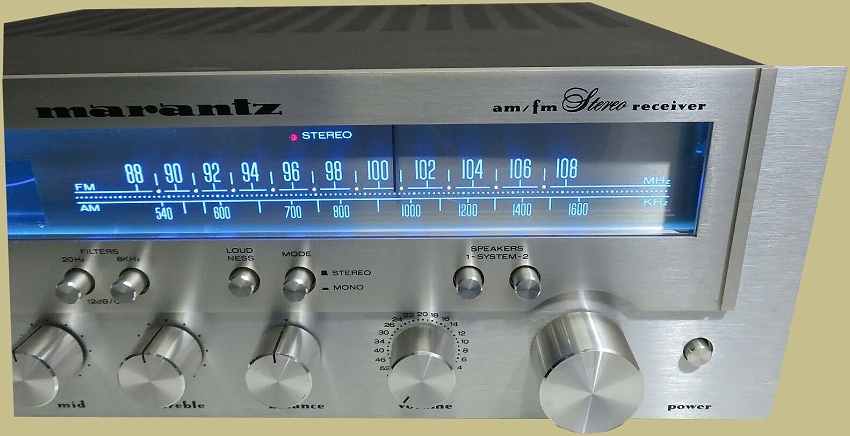
Replacing the lamps in the 1550 receiver is not necessarily easy. There are four lamps total. The two tuning dial lamps are accessible by removing the cover. However, the two meter lamps are a bit more difficult as they require removal of the front panel. The left meter lamp can be replaced with the front panel removed but the right meter requires removal of the meter cover module to replace it. The lamps are 8v/200ma. Also, when removing the front panel remember that the tuning knob is held in place with a 1.5mm hex set screw.
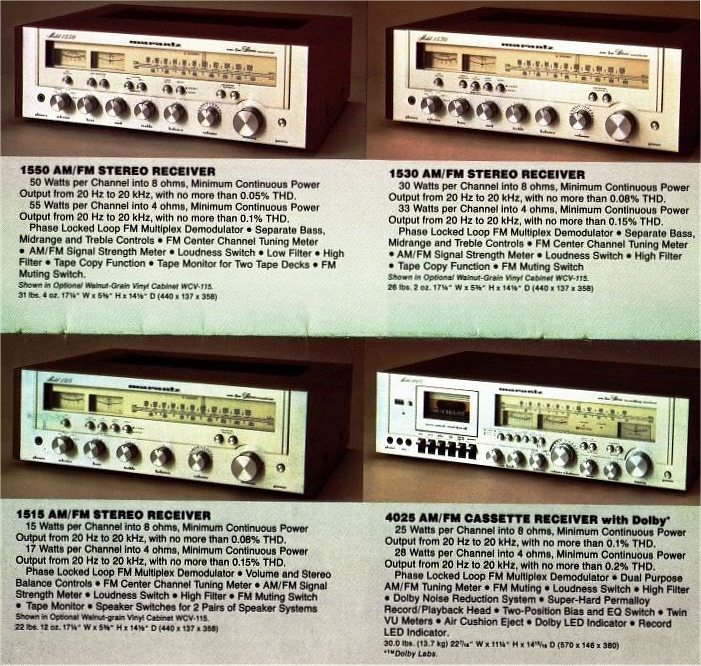
Specifications
- Tuning range: FM, MW
- Power output: 50 watts per channel into 8Ω (stereo)
- Frequency response: 18Hz to 30kHz
- Total harmonic distortion: 0.1%
- Damping factor: 41
- Input sensitivity: 2.8mV (MM), 180mV (line)
- Signal to noise ratio: 72dB (MM), 80dB (line)
- Output: 500mV (line)
- Semiconductors: 3 x IC, 51 x transistors, 38 x diodes, 1 x FET
- Dimensions: 17 1/4″ x 5 3/8” x 14 1/8″ (440 x 137 x 358mm)
- Weight: 31lbs 4oz (12kg)
The 1550 had an optional walnut grain vinyl cabinet (WCV-115). This cabinet was used for the 1515, 1530 and the 1550. Here it is with the cabinet.
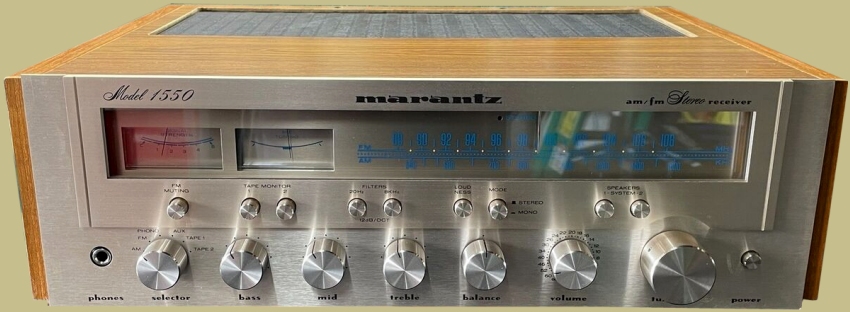
The inside of the Marantz 1550 is well put together and the layout is efficient. Some units have steel endcaps on the transformer while others do not. The 1550 has one IC on the tuner board and two small op amps in the phono stage. Though not built as well as earlier Marantz models it’s not bad. Cost cutting was starting to occur in the late 70’s and the 15xx series is a reflection of that, but they are still pretty well designed. They were made in Japan.
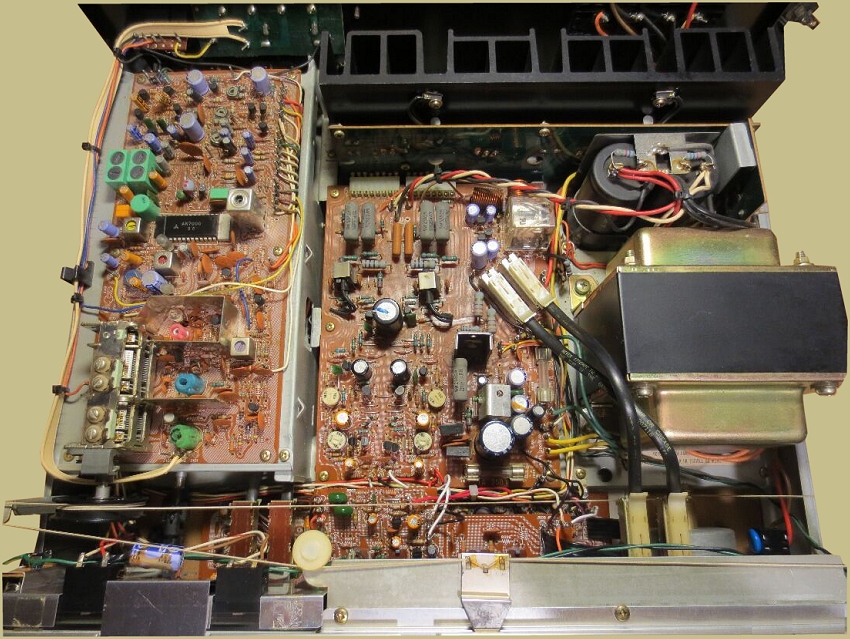
Rear Panel
The Marantz 1550 receiver connections for both FM and AM antennas.
FM Antenna:
To use a dipole type FM antenna just connect its leads to the terminals marked “300” on the receiver’s back.
AM Antenna:
The 1550 features a built-in AM ferrite-rod antenna located on the rear panel. For optimal AM reception, swing out this antenna. While sufficient for areas with strong signals, an outdoor antenna may be necessary for weak signal areas.
Speaker Systems:
The rear panel of the 1550 receiver can accommodate two pairs of stereo speakers with the primary pair connected to system 1 terminals and a secondary pair to the system 2 terminals.
There is one phono jack for connecting turntables equipped with magnetic phono cartridges.
A chassis ground binding post near the phono input allows the connection of a turntable ground wire to reduce potential hum.
The auxiliary Jack is a high-level input jack to accommodate various audio sources such as tape recorders with built-in playback pre-amplifiers, ceramic phono cartridges, additional tuners, or TV sound outputs.
It has two tape monitor jacks. There is also one unswitched AC outlet for powering associated audio components.

Reviews
“Puts out great bass and sharp treble. A very under rated model IMO.”
“Sounds much cleaner and clearer than my old Kenwood KR-3400.”
“I’ve got the Marantz 1550 receiver. Thing is a beast.”
“The 1550 is a sleeper in my opinion.”
When Philips bought the Marantz brand from Superscope in 1980 they rebadged the 1550 as an MR255. You can see the similarity (exact) in the picture below.
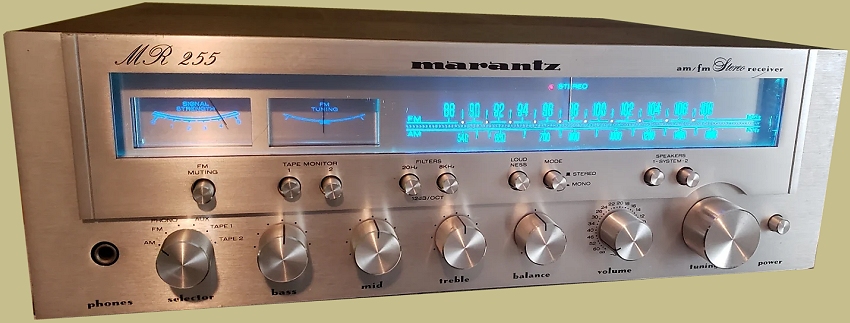
Overall, the Marantz 1550 is a pretty good receiver. It’s not the same quality as the older Marantz models but it does the job for most audio enthusiasts. Also, with the hype and attention on the earlier Marantz models the 1550 tends to fly under the radar. If you’re on a budget and want a Marantz stereo then the 1550 isn’t a bad choice. It looks great and sounds good too.
